Olympia Fields Country Club (North Course), IL, USA
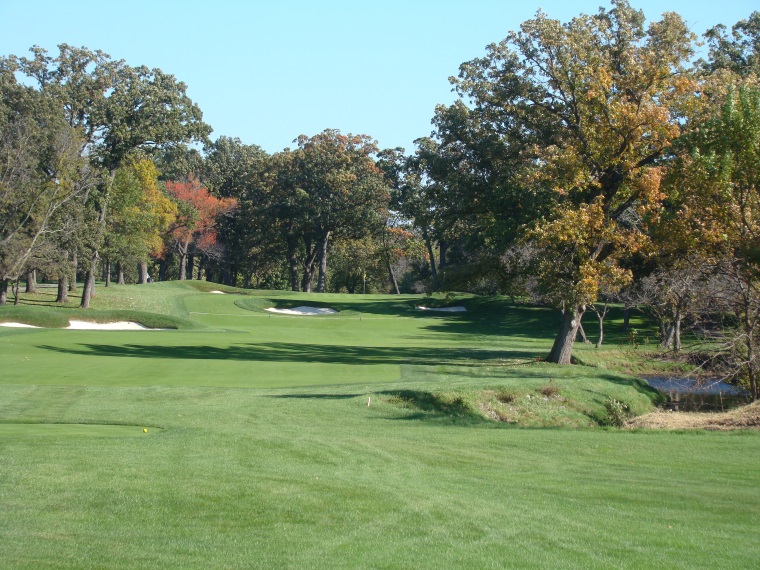
The best holes on the North Course, like the seventeenth, feature topography and the serpentine Butterfield Creek.
Imagine trying to find a 1,000 acre (!) tract of land without a through road or train track in a major metropolitan area. Such a quest sent Charles Beach, founder of Olympia Fields, thirty-two miles south of Chicago in 1913. Find it he did and his vision of the grandest club in the country soon became a reality.
A Scot, Tom Bendelow, completed the Number I Course in 1916 and two years later the Number II Course, designed by fellow countryman William Watson, debuted. In 1920 the two men collaborated and the Number III Course emerged. Is this where Chicagoan Mike Keiser learned to roll out courses?!
The club’s name, which invokes the mythical abode of the Greek gods, is symbolic and purposefully chosen. American college football legend, Amos Alonzo Stagg, the club’s first president, penned this beautiful analogy:
The Olympia of old stood for the highest development of the physical by a selected few; the New Olympia stands for the continual recreating of the physical powers of many men worn by the strenuosity of modern life. Ancient Oympia represented the acme of physical ambition; our modern Olympia represents the superlative of re-creative opportunity. The ancient Olympia was beautiful with her level plain and adjacent groves; but our modern Olympia with many plains and many groves, with uplands and valleys and lovely vistas greatly surpasses the beauty of ancient Olympia.
Willie Park Junior arrived in 1922, right at the height of the Golden Age in golf course architecture, to build a showcase fourth course on the northern section of the property. In all of golf, only the Pinehurst Resort in North Carolina and St. Andrews in Scotland could match Olympia Field’s tally of 72 holes. Rightfully, the members took great pride in what had quickly unfolded at their nascent club.
Fortuitously, all three architects that created Olympia Field’s astonishing cluster of four courses hailed from Scotland and were intimate with golf at St. Andrews. Like it or not, The Old Course defines great golf as that which brings the most pleasure to the most people possible. Ron Whitten noted in his Feature Interview, ‘the only true influential course I can think of is the Old Course at St. Andrews. Everything in golf architecture is pretty much either a reaction to it or a reaction against it.’
How true! During a low ebb for golf architecture, roughly between 1955 and 1985, designs swung away from being fun and too much emphasis was placed on difficulty. The moniker ‘championship course’ became narrowly defined, epitomized by the infamous “Massacre at Winged Foot” in 1974. Today, a plethora of courses are being built with 60 yard wide fairways which might suggest that the pendulum has swung too far in the other direction, where courses become a bomber’s paradise.
Rare is the man who understands where the balance lies, to test the best while providing enjoyment for the rest. Not surprisingly, The Old Course figures into the answer. Those golf architects who have taken the time to study her are invariably the ones who deliver designs that both examine and captivate. To be a Scottish golf course architect at the turn of the last century truly meant something – and Olympia Fields became a direct beneficiary.
Without question, Willie Park Junior is one of the titans who emerged from the hallowed ground around the Firth of Forth between North Berwick and St. Andrews. As I put forth in the Huntercombe Course profile:
…… a descendant of one of golf’s most famous families, his father Willie Park Senior won the first Open Championship and three others. His uncle, Mungo also became Open champion and the brothers made a further name for themselves by founding a well known golf club and ball company in Musselburgh, Scotland. Park Junior himself won the Open in 1887 and 1889 while helping to run the family business. From this pedigree, Park developed strong ideas as to what constituted good golf.
Around the turn of the last century Park built three of England’s finest inland courses, Sunningdale Old, Notts and Huntercombe. After World War I he concentrated his talents in the United States where there was greater economic opportunity. Tim Cronin, author of Golf under the Clock Tower, tells how Park came here: ‘He was first hired in 1919 by the club to review and modify the first three courses, concentrating on No. 3. Park spent four days and came up with improvements for all three. The minutes aren’t specific, but the presumption is that the board liked his work so much, they hired him for No. 4.’
At Olympia Fields he was given one of his best canvases. Golfing great Chick Evans described the property: ‘Twelve holes of the eighteen are located on the hilliest of the gently rolling land, not too hilly, but with good sporting hazards. The creek crosses and re-crosses the greens in an interesting way, and the course itself is a joy where each good shoot is rewarded and each bad shot is sharply penalized.’ About the course Park wrote, ‘I am satisfied now that your Number IV Course is the equal of any golf course I have ever seen and I know of none that is superior, either in beauty or natural terrain.’
Few courses have hosted the U.S. Open and PGA Championship, let alone multiple Western Opens, which were more prestigious than the PGA in the early days. Park built the course to host big events and the membership fulfilled that destiny. Park, himself, invoked the term ‘championship course’ in describing his challenge when he wrote, ‘I have never seen a more natural setting for a championship course.’

Note how Park incorporated this diagonal ridge into the driving zone of the fourth. His forty days on property were well spent.
Of course, Park laid out the holes in the age of hickory golf and the game has radically changed since. Keenly aware of its place in history and wishing to make more, the club managed the course accordingly. For their efforts, they hosted Jerry Barber’s 1961 PGA Championship and Western Opens in 1968 and 1971 won by Jack Nicklaus and Bruce Crampton respectively. Yet, aerials trace the course’s evolution and how modifications had altered Park’s design intentions. Bunkers had been pushed directly in front of greens, walling off access via the ground. Trees were planted and fairways became ever narrower with the expansive foliage. The course was testing and remained championship-worthy but some of its charm gone.
An auspicious era dawned when the club reached agreement with the United States Golf Association to host the 2003 U.S. Open. That precipitated a bunker renovation by architect Mark Mungeam that eliminated the oval, two-dimensional saucers that plagued the course (and indeed most courses in Chicago) and saw the emergence of deep, grass-faced hazards that were more appropriate to the property’s grand scale. As an aside, it is worth noting that these bunkers are hand raked to this day. For that U.S. Open the course was every inch a tight parkland course that demanded aerial golf of the highest order. Jim Furyk seized control early on Sunday and the back nine became anti-climatic.
While the golfing world was pleased to become reacquainted with Olympia Fields, club officials realized that something was amiss. The overall picture was appealing but the devil was in the details. Freshly discovered aerial photos from 1938 and 1961 provided the necessary clues. One take-away was how the open farmland section of the course that houses a majority of the first twelve holes had become over-treed. Some of the glorious long internal views referenced by the club’s founders were gone and the diversity of the property had become muted by unchecked tree growth. Happily, Sam MacKenzie came up from Broadmoor Country Club in Indianapolis as the Green Keeper in 2006. For his part, MacKenzie immediately began felling non-specimen weed trees and the firmness of the turf and the depth of its roots improved with the increased light and circulating air. Ash woods, which can be handsome but choke off light and views, were afflicted by disease and, mercifully, also came down.
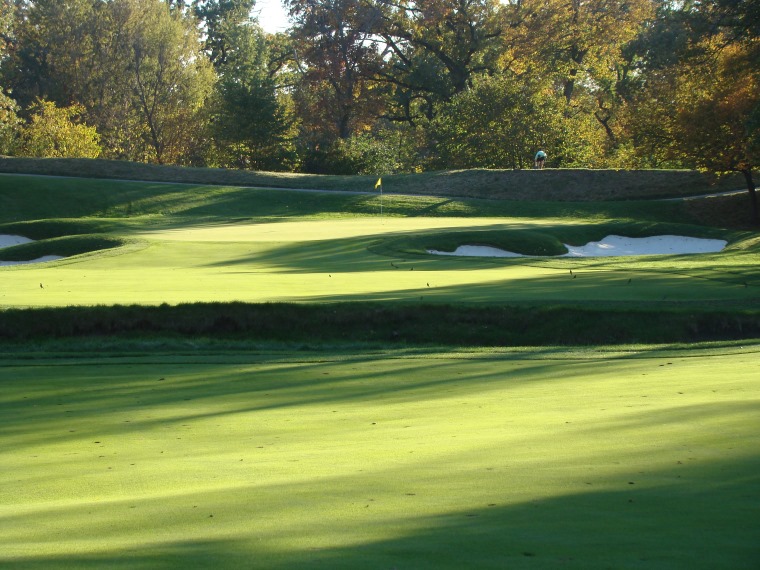
Look at how the twelfth green is swathed in sunlight. Prior to the 2003 U.S. Open, trees impeded conditions for such healthy turf. Though the soil is heavy, when nature cooperates, MacKenzie can give the members the green grass they cherish while giving an organization like the U.S.G.A. fast and firm.
In studying the aerials, it became apparent that Park had imbued the course with more ground game options than presently existed. For instance, fronting bunkers that walled off the fifth and eighth greens didn’t exist in the 1938 aerial. Take a look below.

This 1938 aerial highlights how Park’s course fell across a mix of open farmland and forest with Butterfield Creek roughly bisecting the two. Greens 5 and 8 are identified.

This 1961 aerial reveals the tree-planting and altered bunker patterns. Note how the 5th and 8th greens had been effectively sealed off by fronting bunkers.
Green Chair Andy Revell latched onto these aerials as the means to move forward and recapture the course’s Golden Age playing qualities. Mungeam updated the long range master plan. Seeking approval, the board sent a letter to the members in 2012. The priorities were listed in this order:
• Improve member experience
• Maintain or restore the historic features of the course
• Keep the course relevant for the best players in the world
That’s exactly what happened. A new set of Senior tees was created at 5,900 yards, that has proven to be quite popular. The pond that had been extended into the eighteenth fairway was shrunk back to its original size (no need to worry: the hole still played the hardest for the 2015 Amateur). Classical features like the grass island in the fairway bunker down the first were restored, further reconnecting the course with its Golden Age roots.
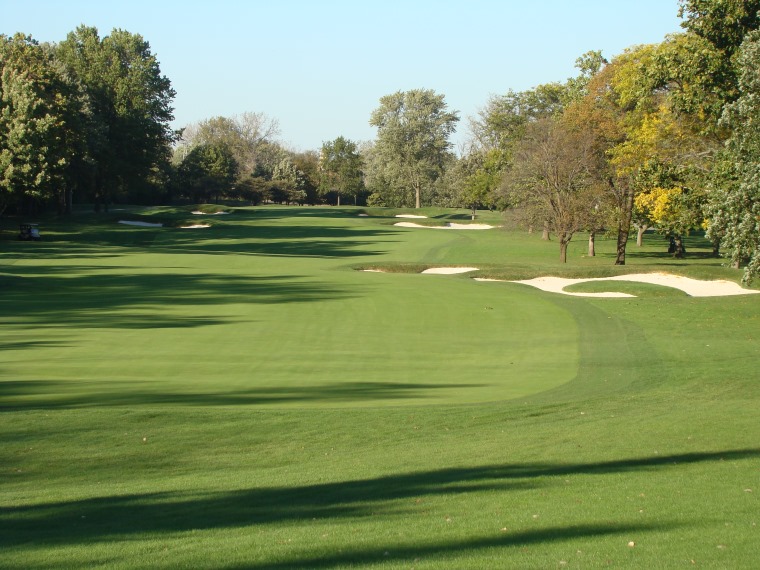
Note the distinctive bunker down the right with a grass island in the middle. The 1938 aerial showd this feature and Mungeam was quick to push for its restoration in 2013.
Olympia Field’s fifth hole (marked in the aerials above) makes for an interesting case study. While Park had placed a bunker in front of the green, it was a good twenty paces from the front edge with a primary purpose to hinder depth perception. A modern bunker was later placed directly against the putting surface, which at only 25 yards in depth was the shallowest target on the course. The green only accepted one sort of shot: a high soft approach. Dictating what the golfer must do is the antithesis of what makes Golden Age designs special. Concurring with Mungeam’s proposal, the club returned the bunker to Park’s position.
To the author this was a win for golf. Too many clubs compromise their identity in a quest to host major championships only to suffer a design the memberships can’t handle. By pulling the bunker away from the fifth green all players are afforded more options. Brilliantly, the bunker’s high face creates an unseen dead zone between it and the green. The tiger doesn’t know what to do: trust his eyes that suggest a shorter distance or heed his caddie who is calling for more club. While the tiger is unsettled, 95% of the membership (its core!) enjoys more latitude in tackling the hole.
Bunkers judiciously set away from greens were commonplace in the Golden Age. Another example is at the eighth, also marked in the aerials above. Always a long one shotter, Park prudently had an open area in front of the green to allow players to scoot their tee ball onto the putting surface. At some point ground access became sealed off by a right front bunker. That adulteration rendered the hole one-dimensional. As part of Mungeam’s 2013/2014 work, the offending bunker was shrunk to restore ground options. It was clearly the proper treatment for a one shotter that stretches to 280 yards – but ‘proper’ isn’t always what transpires at clubs blinded by the spotlight that comes with hosting national events. Olympia Fields deserves full kudos for enabling the enjoyment of juniors, women, seniors and anyone with a handicap greater than 5. Olympia Field’s actions are heartening and demonstrate how a club can have the best of both worlds, as we see below.
Holes to Note
Please note: Two yardages are given, one from the back markers where the course measures 7,355 yards (against a tight par of 70, mind you!) and the more cheerful 6,535 standard, which is 45 yards longer than Park’s time.
Second hole, 465/425 yards; In Parks’s day a single bunker was sufficient to pivot the hole to the right. Today, since a greater variance than at any point in the game’s history exists between good club golfers and the tiger off the tee three deep fairway bunkers extend seventy-five yards within the bend of the hole. In this manner, the course stays relevant for championship play while remaining true to Park’s design. Solving this conundrum for Golden Age clubs desirous of hosting major events is no easy task. Clubs like Olympia Fields face more complex decisions than clubs content to preserve a course strictly for member play. Job well done.
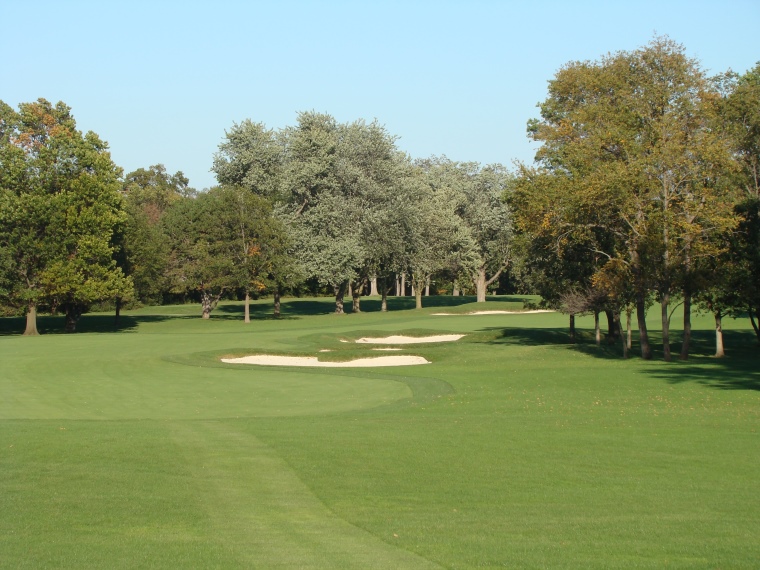
The string of three bunkers down the right extend long enough to be relevant to all players. As part of the 2013/2014 work, ingress in and egress out of all the bunkers was improved.
Third hole, 460/410 yards; Two-shot holes define the lasting merit of most courses. That’s because there are generally more of them than the 3s and 5s combined. And, golf at its essence is ‘hitting a ball, finding it and hitting it again’ – the very definition of a par 4. Olympia Fields possesses at least two (3 and 14) hyper-distinctive par 4s, that help elevate it to a class above city rival Medinah. As seen at Mt. Bruno, Sunningdale Old and Notts, Park was quick to embrace burly two shotters in his designs – and talented enough to create memorable ones.
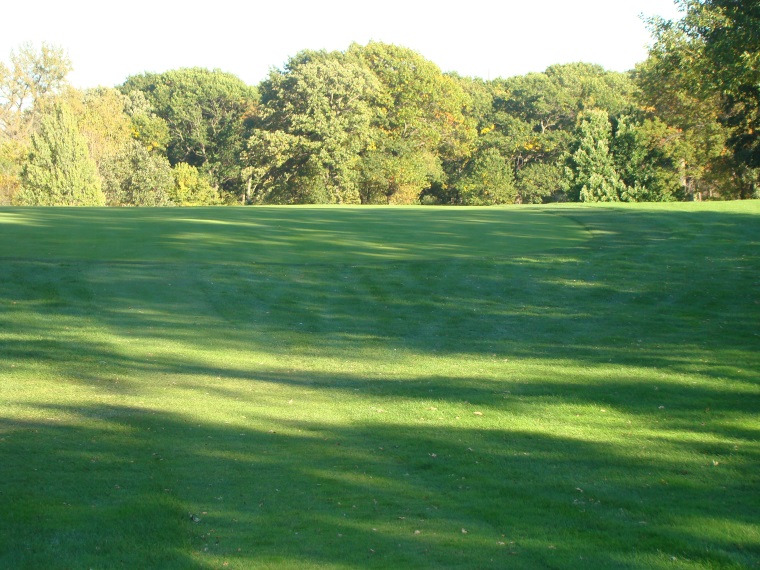
No ground was disturbed (thank you very much!) on the third where the golfer enjoys the sight of his ball sailing over the crest of the hill – he certainly won’t see it land.
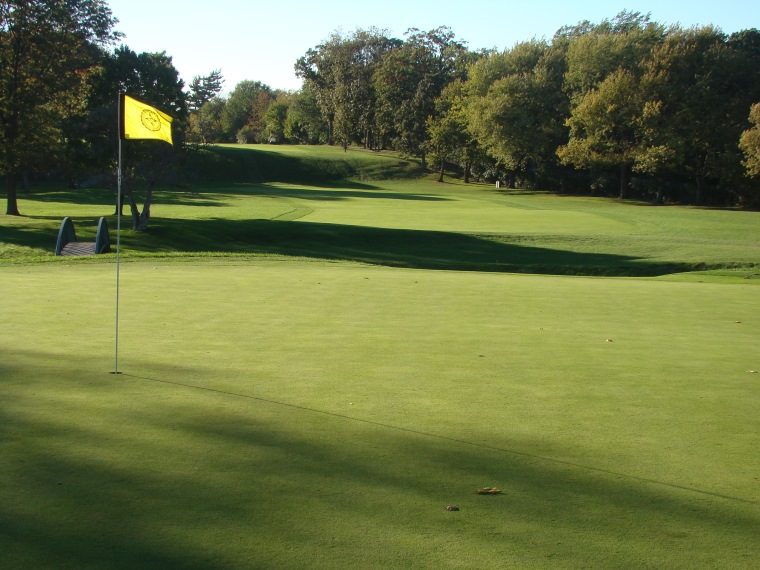
Looking back, the golfer appreciates the twenty-five foot stair-step descent approximately 250 yards from the championship markers.
Eighth hole, 280/200 yards; Similar to what occurred at the fifth, a modern, fronting bunker was repositioned and ground game options – mercifully – restored at this beastly one-shotter. Finding ways to get the modern bomber to hit a controlled shot with a long club is increasingly difficult. This hole succeeds admirably, despite the pouty expression that good players adopt on the tee.
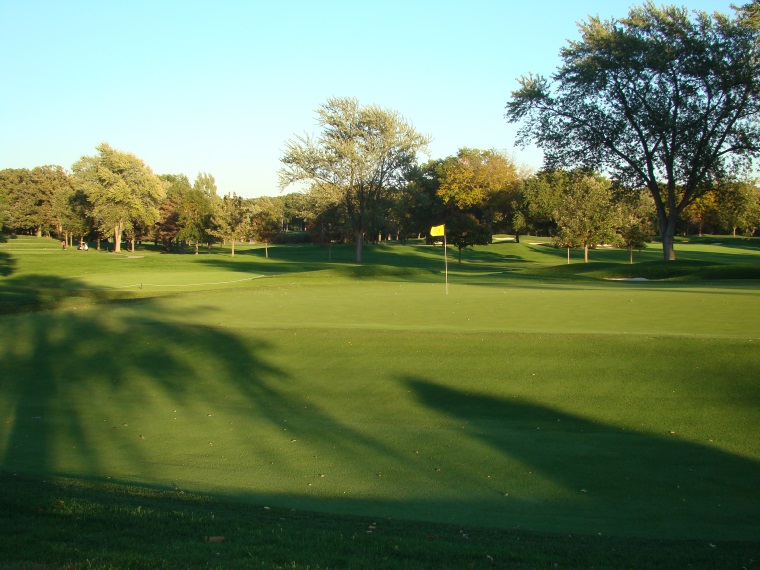
As seen from back right, tight turf was introduced along the right side of the eighth green. Balls that trickle over are no longer held close to the putting surface by a collar of rough. A greater variety of recovery skills is now required of the tiger while the club member happily putts up the slope.
Ninth hole, 470/440 yards; This gorgeous two shotter becomes the home hole during major events. To the author, it is the only beneficiary of the hole re-sequencing imposed on the course by the U.S.G.A. for the 2003 Open and 2015 Amateur. It’s preferable as a finisher because of superior bunkering, lack of water and the increased presence of the clubhouse. Regardless, each nine ends with a bruiser and it’s no surprise that those two holes were the most difficult for the stroke play portion of the Amateur. The downside to the U.S.G.A. order is everything else because, regrettably, the superior back nine is played first and the all-world fourteenth buried as the measly fifth.

One of the largest fairway bunkers on the course slashes at an appealing diagonal into the ninth fairway.

While the tiger can fly his ball onto the putting surface, the rest of us are free to concoct some sort of runner that scoots between the bunkers. The green seems to rise organically from the fairway. Both sets of players need to take care to keep their approaches below the hole.
Tenth hole, 445/410 yards; Giving the golfer something varied to do is at the heart of good design. Too many straight holes and attention wanders, which frankly appears to have been the shortcoming of Willie Watson’s defunct Number II Course. With Park you’ll won’t encounter hard doglegs, which can be clumsy, but lesser bends. That’s true at Sunningdale, Notts, and Mt. Bruno as well as. This hole, two, seven, nine, eleven, fifteen and eighteen all elbow slightly one way or the other and allow the better player who can shape the ball to gain an advantage off the tee.
Eleventh hole 395/360 yards; This hole commences a three-hole sequence rarely found on a course built for big events. Collectively, the two sub 400 yarders and a cute little one-shotter endear the course to the author. There is no escaping their charms or denying the finesse they demand, attributes lacking at other major championship venues like Bethpage and Baltusrol (Lower).

… with the back right to lower left cant of Park’s green. The closer one hugs the inside of the dogleg, the better the angle of approach. In general, capturing the merits of a putting surface with photography is difficult. Not here – the green’s wicked tilt is evident from over 100 yards away!
Twelfth hole, 390/375 yards; A placement hole in every sense of the word, the twelfth ducks back into the forested portion of the property. Opposed to the eleventh (a hole of similar length) which features six bunkers in the landing zone, the primary challenge here is staying between the hardwoods. After playing the previous five holes on what was open farmland, the twelfth engenders isolated beauty –- but demands accuracy. Beware: this silent assassin played as the fourth hardest hole during the 2015 Amateur as the fairway proved problematic to find, even with shorter clubs off the tee.
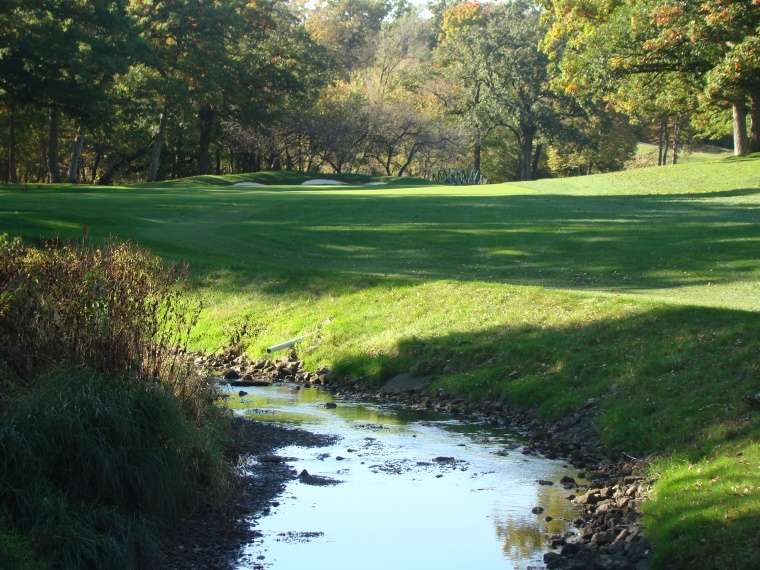
The golfer hasn’t seen Butterfield Creek since his easy drive across it on the seventh tee and delights in its return. Indeed, the meandering creek plays a role in four of the last seven holes.
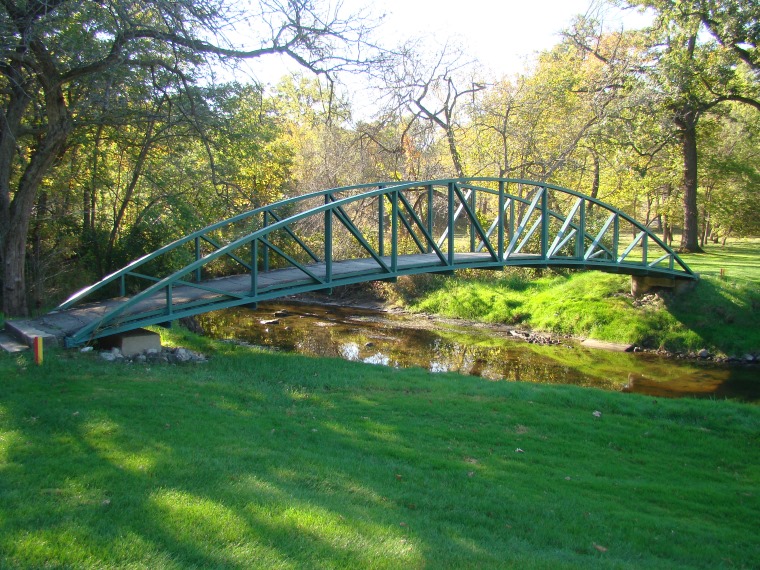
The eight distinctive arched steel bridges that dot the North Course rival the 110,000 square foot (!) clubhouse for artistry. This one spans the creek 70 yards from the green and …
Thirteenth hole, 170/150 yards; Perfectly situated to the right of a forty foot bluff, this little uphiller has many fans. The deepest greenside bunker punctuates the ground front left and countless taxing hole locations exist on one of the course’s best putting surfaces. It has only two level areas. One is left, close to the bluff’s edge and the other is low front right, guarded by two shrewdly placed bunkers. As a former caddie at Olympia Fields, historian Sven Nilsen came to have a greater appreciation for Park’s greens. All but three of them (the third, sixth and eighteenth) are original to his day. Nilsen states, ‘As a whole, the greens on the North course present a wonderful array of internal features. There are ridges bisecting right and left sides (the 5th), precipitous slopes from back to front calling for the deftest touch (the 3rd, 10th, 12th and 14th), deceptive contours that appear to make the ball break uphill (the 4th), a green at the end of an uphill approach that runs away (the 17th) and bowl like collection areas that allow for shots away from the flag to feed to the hole (the 11th and 13th). Add in the larger greens on the course which offer very subtle features (the 7th, 8th and 15th), and one green that seems to combine all of the features noted above (the 18th), and you’re left with a wonderfully diverse mixture of little puzzles to be solved during your round.’
Fourteenth hole, 450/420 yards; Superlatives rain down on this hole, which is the author’s favorite in golf-drenched Illinois, if not the entire Midwest. Few people spoke about the importance of routing holes thirty years ago but today we enjoy a better appreciation of what it means for a hole to be laid out to take maximum advantage of natural features. The ability to route eighteen consecutive holes and not have a dullard in the bunch distinguishes Park from most of his contemporaries. Given the splendors here: high ground for a tee, a low river valley where Butterfield Creek crosses twice in the configuration of a reverse ‘C’, and a high wall on the other edge for a green; one might think that anyone would ‘find’ this hole. Remember, that this was heavily forested in Park’s time and the author doubts that more than a dozen, or maybe, fifteen architects have proven capable of building a hole of such grandeur. This tour de force shows that Park belongs amongst the elite architects.

One of the lasting pleasures of being a member must surely be enjoying the expression of awe on a guest’s face when he stands on the fourteenth tee for the first time.
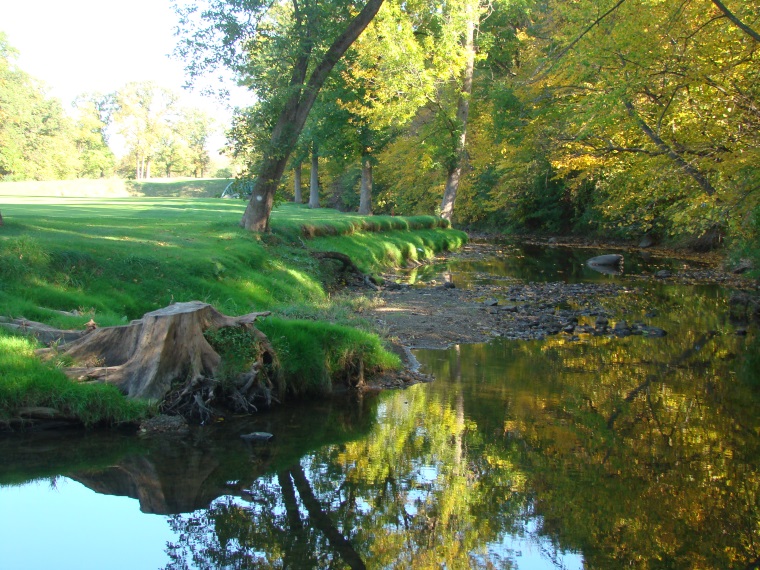
While Green Keepers may disagree, a creek is one of the most wonderful features to bless a parkland course. Here, Butterfield Creek parallels the fairway for 150 yards along the right.

The green is ninety yards back from the steep valley wall. A modern architect might have stuck it dead on top for drama but such a do-or-die approach would overwhelm the average player. As Park has it, the hole is much longer and, indeed, grander. Recovery shots around his green complex are some of the most ticklish on the course. In autumn the hole can’t be placed in the middle of the green, so pronounced is its back to front slope.
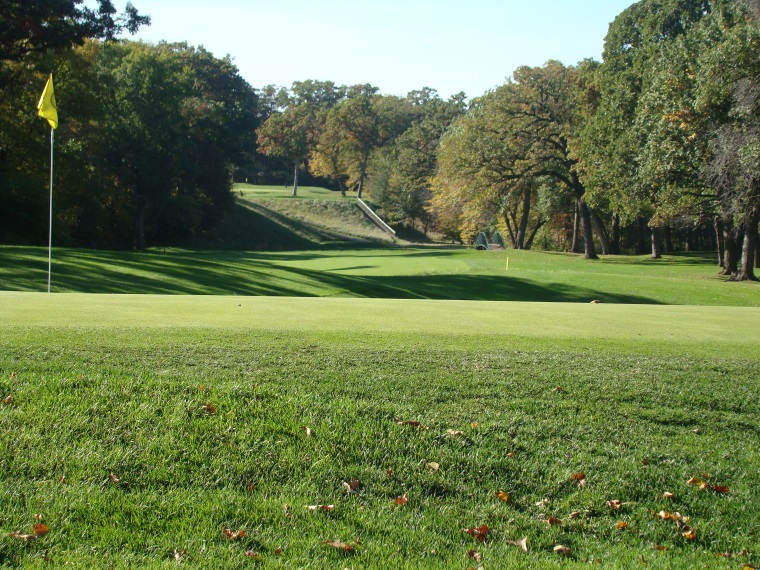
This view looking back down the fourteenth captures the 39 step flight of stairs used to plummet the golfer into the river valley after his tee shot.
Fifteenth hole, 575/550 yards; Variety is the lynchpin of great design. One-shotters that requires a ‘wood’ and true three-shotters liven the mix at any course – the North Course enjoys both. Played along a bluff over Butterfield Creek, this hole would be more dramatic if the bluff’s presence was visually more acute. Regardless, this low profile, stately hole bends right and requires three well placed shots.

The Park bunker in the foreground was restored in 2013 by Mungeam. The hole is full of challenge without resorting to anything forced or contrived.
Sixteenth hole, 215/175 yards; While the next-door thirteenth plays uphill, this one plunges to the lower land and gauging distance correctly is a daunting task. Coming up right or short is unwise. This hole is a particular favorite of many Chicagoans, who are accustomed to flat, prairie golf.

Locating a green site in the elbow of the creek would have come easy to Park. Building up the green pad was a wise pre-caution against future flooding.
Seventeenth hole, 455/375 yards; Park placed only two green sites immediately adjacent to the creek, knowing that it was prone to the occasional flood. Both were par 3s. One was his defunct short sixth and the other the hole we just discussed. More often he used the creek in the fairway to threaten tee balls or to create tension about how to lay up should one miss a fairway. In olden days the creek crossed the fairway twice but for water management reasons, the club altered it and now it rubs along the right side of the fairway for seventy yards in the hitting area. Mungeam added the left hand bunker which works in concert with the creek to addle long hitters.

The best holes at Olympia Fields feature either topography or the creek. The very best, like this one, feature both. The bunker in the hillside is thirty yards short of the green and is another fine example of the club restoring a Park bunker that is well off the putting surface but directly in the line of play.
It’s worth noting how effortlessly the club has picked up over 900 yards since Park’s day and many of the green to tee walks are actually shorter. Such is the advantage of beginning with a spacious property. However, the sixth represents an evolutionary misstep where a new intermediate par 3 was built in lieu of Park’s little downhill pitch. In a vacuum, the new hole is plenty fine but the lengthy 180 yard walk back to the next tee is unacceptable on a Golden Age course. A restoration of Park’s hole would be most welcome and further highlight the diversity found across his best creations.
Speaking of special, the Number I Course (the South Course) was enhanced by Steve Smyers in 2007/8. Some argue that it’s the equal of the North Course. All agree that the cute little two shotters found at the sixth and eleventh are among the best holes on the property. While the ninth was borrowed from William Watson’s Number II Course, the course shows a much higher degree of design sophistication than Bendelow’s earlier works around the turn of the century. People who play it gain a fresh appreciation for ‘The Johnny Appleseed of American Golf.’ Having two courses of such quality made Olympia Fields a dream host for the 2015 U.S. Amateur.
In comparing the two, Sven Nilsen remarks,
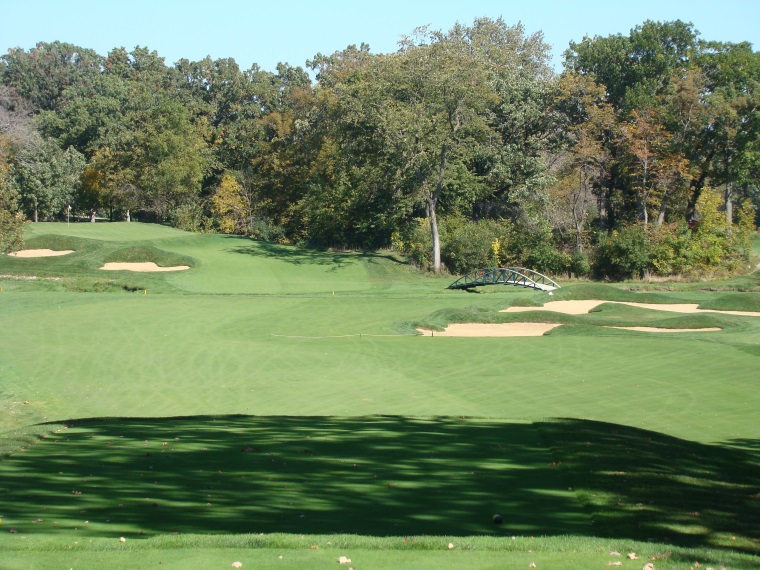
Tom Benedelow’s infamously well placed sixth green on the South Course features severe drops – twenty feet left – and thirty feet right!
As demonstrated by the 2015 U.S. Amateur, you can have a course that tests the best and yet is fun for regular play. Recent tweaks include the removal of non-specimen trees, the contraction of a water hazard, the creation of a sub-6,000 yard set of tees, and repositioning of bunkers that had walled off the fronts of greens. These changes are all part of finding a much needed equilibrium and shout a message that the golf world needs to take to heart.
Olympia Fields with a history unlike any other is again living up to its lofty name.

The Olympia Fields train station is a scant hundred yards from the first tee, allowing members in downtown Chicago free to do their best Bernard Darwin imitation.


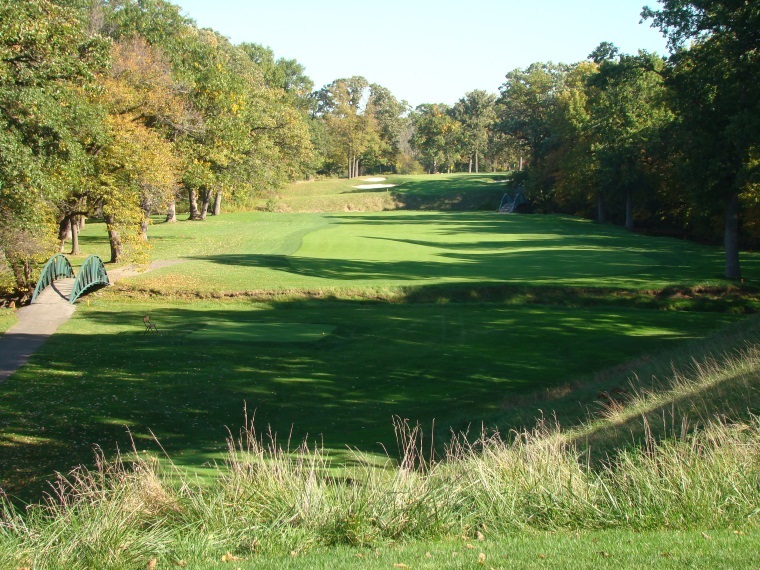
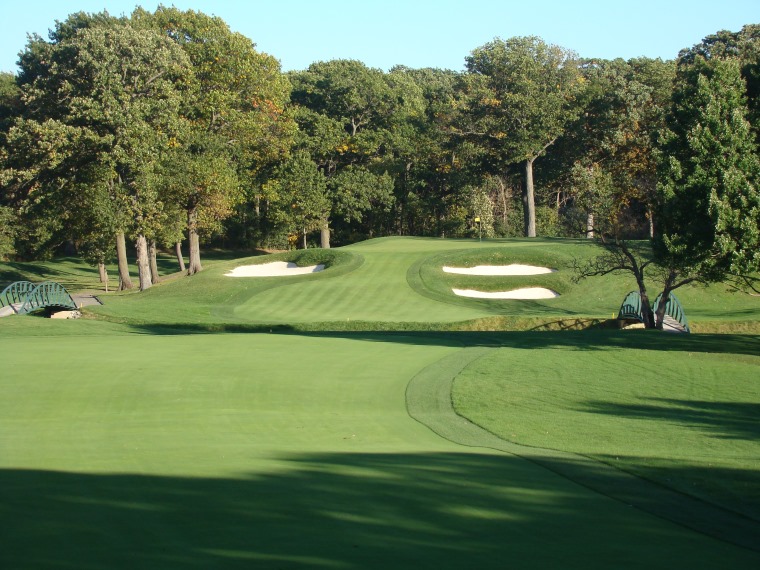
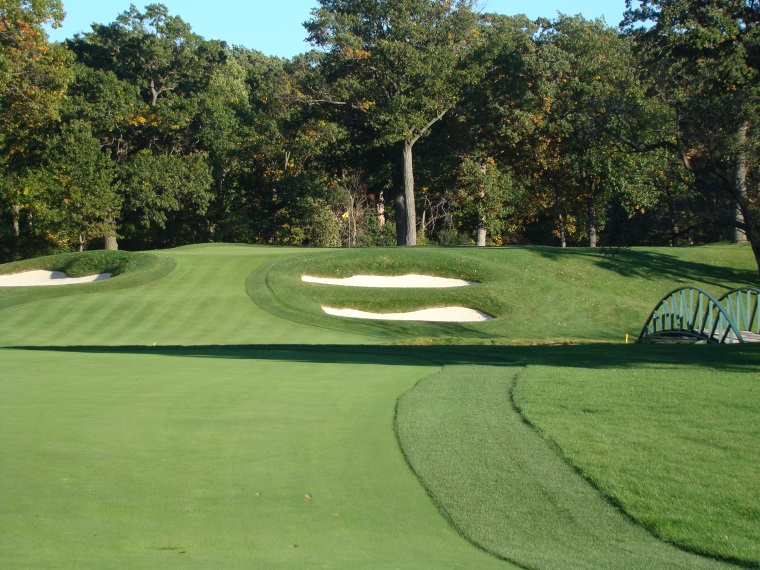
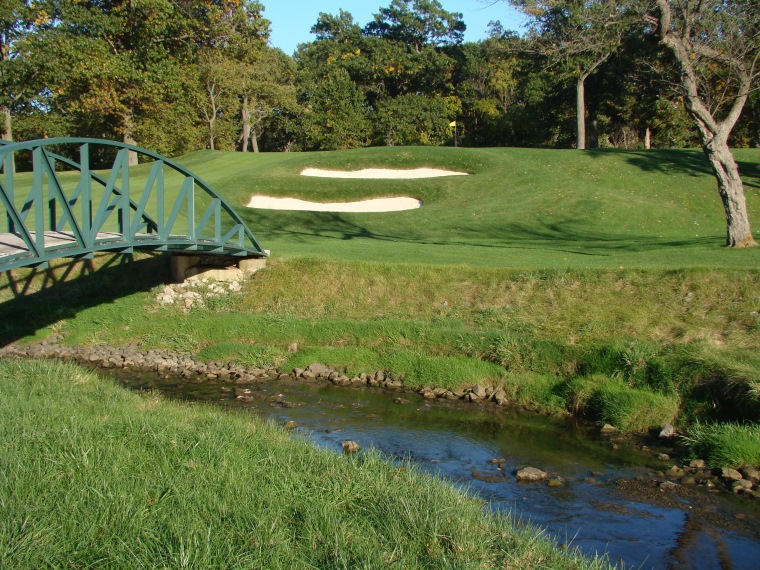

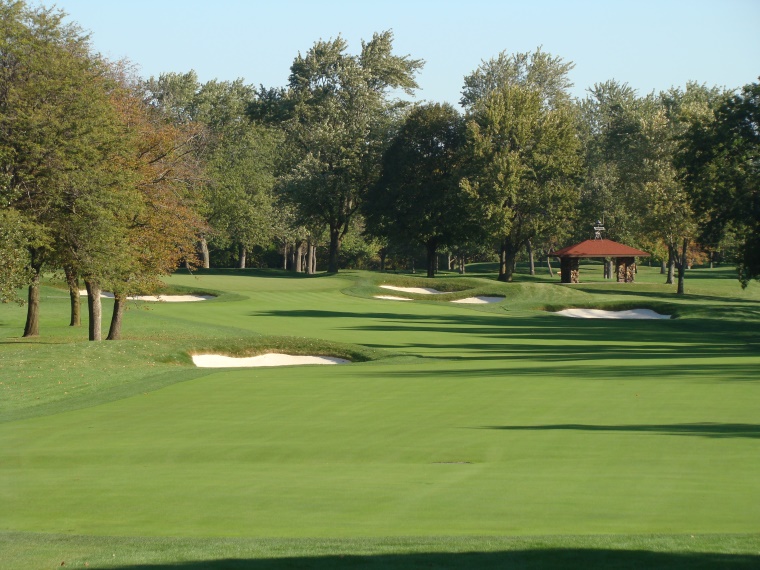
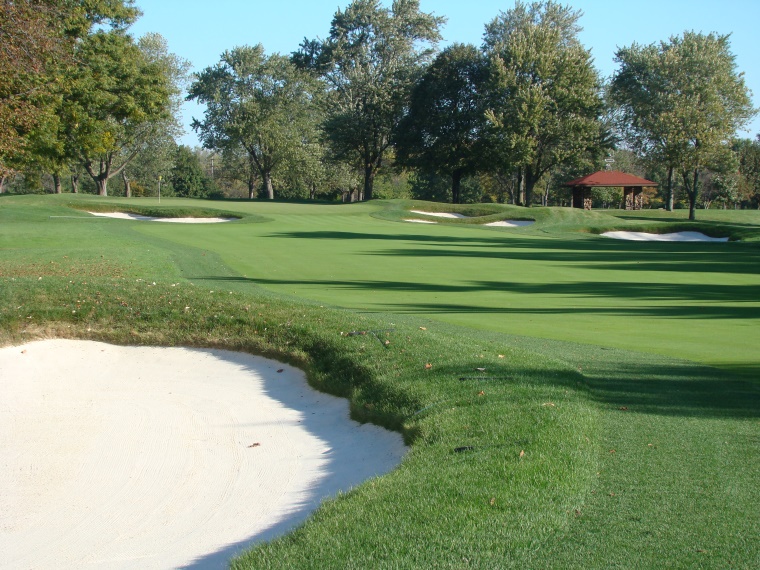
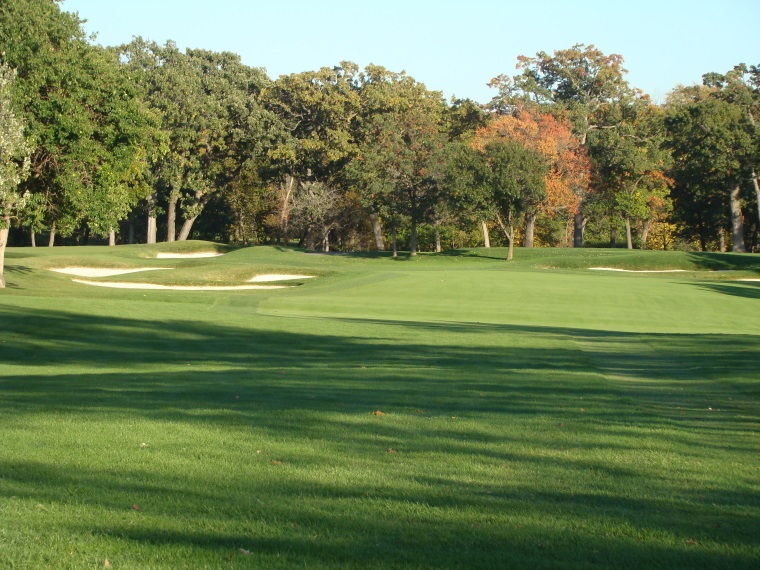

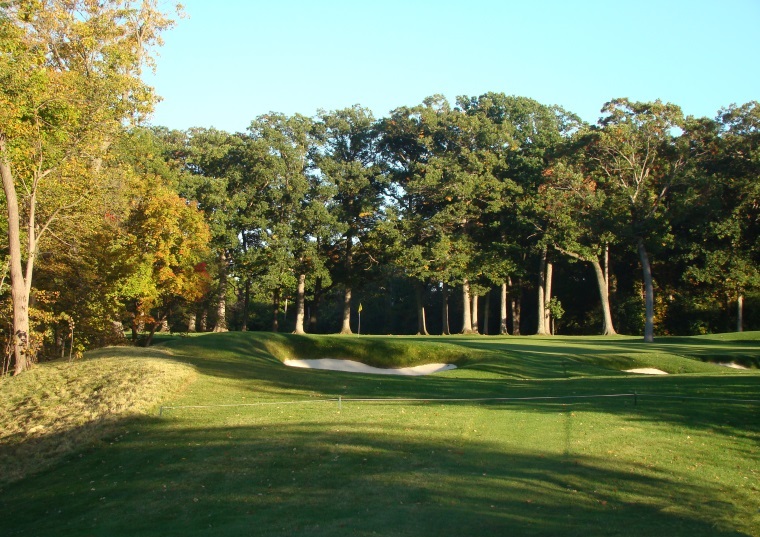
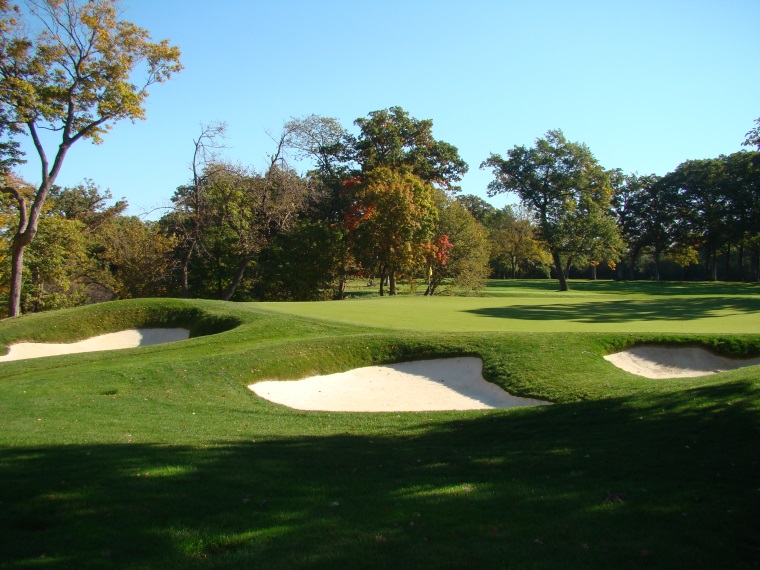
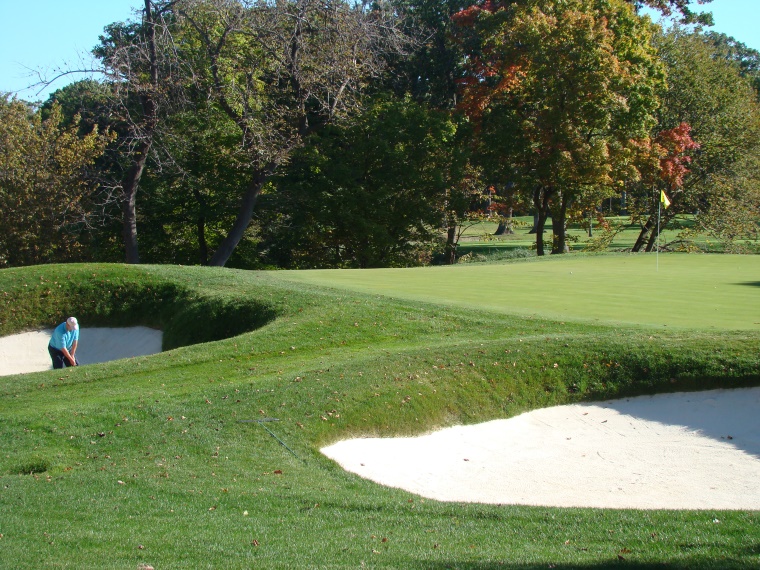
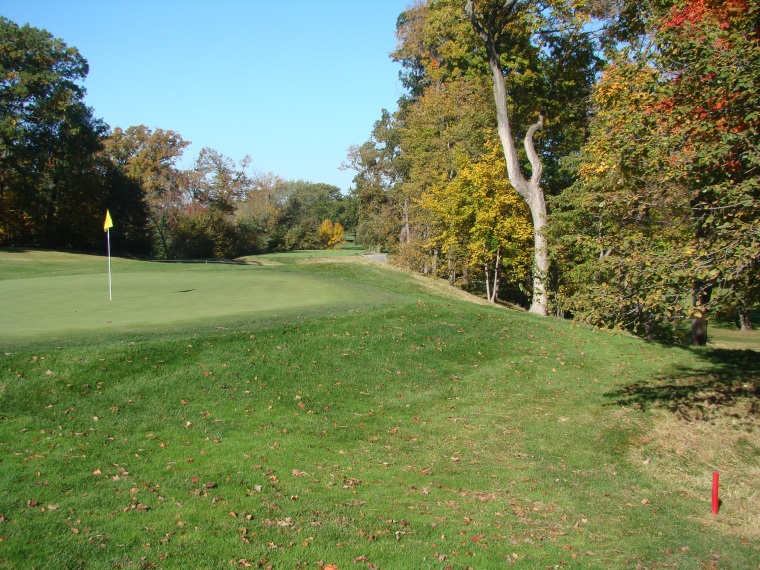
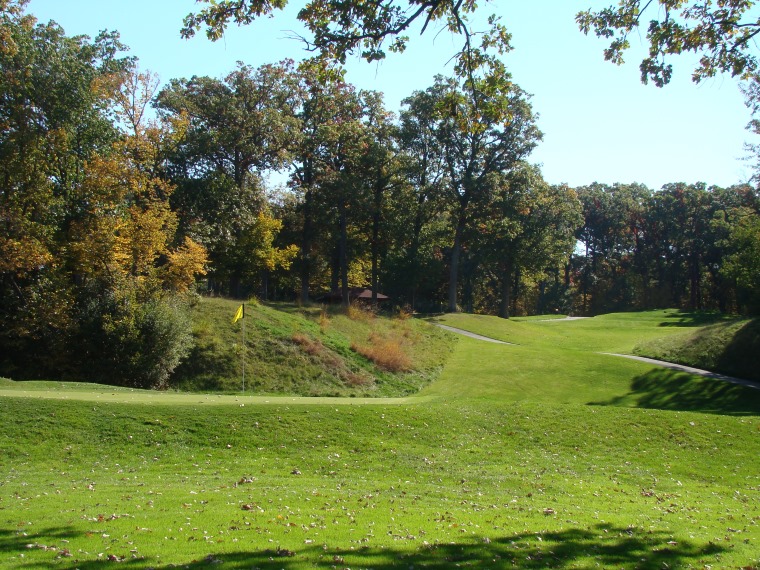




![The Park, West Palm (Lit 9) [2023]](https://golfclubatlas.com/wp-content/uploads/2024/12/IMG_7092-2-scaled-500x383.jpg)


